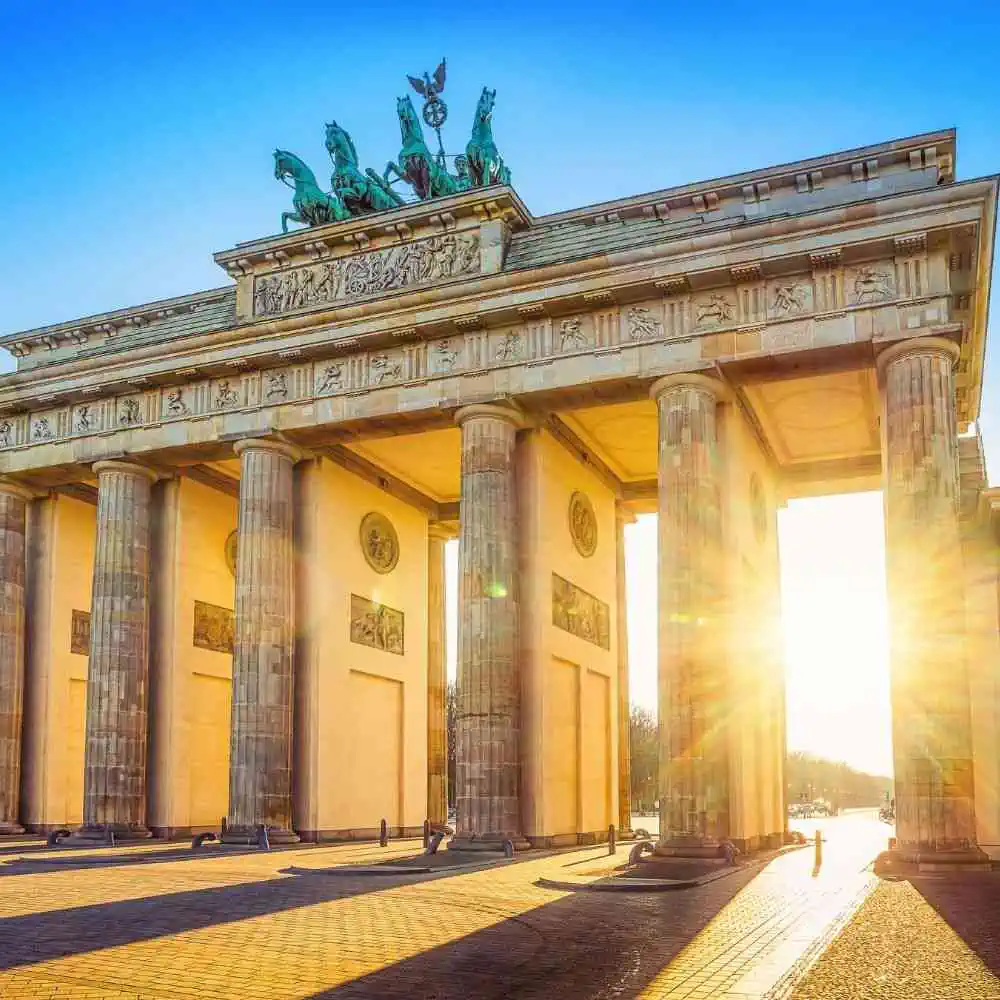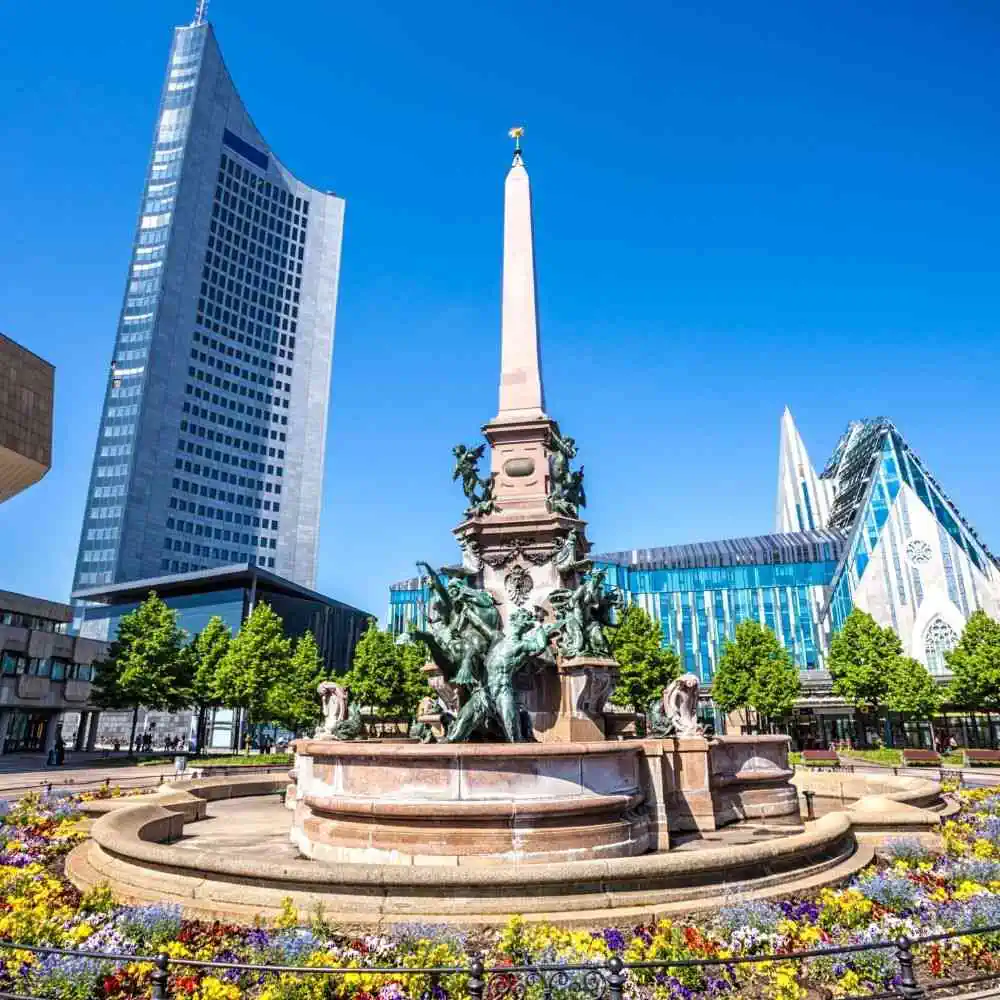You will depart from Leipzig Hbf, located right in the city center of Leipzig, and enjoy the beautiful scenery of the journey while you arrive in Berlin Hbf, also located in the heart of Berlin.
Trains from Leipzig to Berlinfrom € 29.00
Trains from Leipzig to Berlin
Travelling by train: Leipzig - Berlin
The train will stop at several stations in Berlin, allowing passengers to explore different parts of the city. The most iconic item you can find during the departure is the beautiful clock tower, located at the entrance of the station.
Arriving in Berlin The train will arrive at one of two stations in Berlin, either Berlin Hauptbahnhof or Berlin Ostbahnhof. Both of these stations are centrally located and have easy access to the city's attractions. The most iconic item you can find at the station is a replica of the Berlin Wall, which is a reminder of the city's difficult past. There is also a huge selection of souvenirs and local gifts to be found at the station, as well as a wide variety of restaurants, cafes and shops.No matter which station you decide to get off at, you will always have a great time in Berlin, with so much to explore and experience. From historical monuments to modern art galleries, there is something for everyone.
Conclusion Travelling from Leipzig to Berlin by train is a great way to explore the two cities. From the iconic clock tower in Leipzig, to the replica of the Berlin Wall in Berlin, the journey is sure to be a memorable one. Whether you're visiting to see the sights, explore the culture, or just relax, the journey from Leipzig to Berlin is the perfect way to get to both of these beautiful cities.
Journey details
How long does the train from Leipzig to Berlin take? The journey from Leipzig to Berlin takes approximately 2 hours and 18 minutes.
What is the fastest journey from Leipzig to Berlin by train? The fastest journey from Leipzig to Berlin by train takes approximately 2 hours and 7 minutes.
How much does the train cost from Leipzig to Berlin? The train from Leipzig to Berlin costs between €14 - €25.
How much does the Leipzig to Berlin? Yes, there is a direct train from Leipzig to Berlin.
What is the distance from Leipzig to Berlin by train? The distance from Leipzig to Berlin by train is around 300km.
Which are the cities that the train stops from Leipzig to Berlin? The train stops at Magdeburg, Brandenburg, Potsdam, and Friedrichstraße Station before arriving at Berlin's Hauptbahnhof.
Buy train tickets from Leipzig to Berlin
Traveling by train from Leipzig to Berlin is an easy and comfortable journey. RailClick is the best way to travel Europe by train.
Leipzig: Places to see
Leipzig, in Germany, is a vibrant city with a rich cultural and architectural heritage. It is home to many stunning monuments, churches, and other historical sites that are worth visiting. From its iconic Town Hall to its impressive Old City Hall, there is something for everyone to explore in this ancient city. For those looking to indulge in some delicious local eats, Leipzig’s culinary scene is bursting with gastronomy treats. Here is a list of must-visit historical and architectural sites and what to eat during your ideal trip to Leipzig.
Old City Hall (Altes Rathaus): Located in the heart of Leipzig, this mighty building is a remnant of the Middle Ages. Built in 1556, the Old City Hall is one of the city's most imposing historical structures. It has a beautiful staircase, a magnificent ceiling, and the historic Thalia Hall. The entrance is free and the opening hours are from Tuesday to Sunday: 10am-5pm (Closed on Mondays).
St. Thomas Church (Thomaskirche): This incredible structure is the official home of the Thomanerchor, the world-famous boys choir founded in 1212. It is also the final resting place of composer Johann Sebastian Bach. It is located in the center of Leipzig and visitors can access the church for free. The opening hours are 8am - 6pm from Monday to Saturday, and from 12pm - 5pm on Sundays.
Leipzig Town Hall (Rathaus): This impressive Renaissance-style building is one of the city's most iconic landmarks. Built in 1556, it is a symbol of the city's illustrious past. The entrance is free and the opening hours are from Tuesday to Friday: 10am-5pm and Saturday to Sunday: 10am-6pm.
St. Nicholas Church (Nikolaikirche): This baroque church is one of the city's most important religious sites. Built in the early 18th century, the St. Nicholas Church is a testament to Leipzig's proud history. The entrance is free and the opening hours are Monday to Friday: 10am-5pm and Saturday to Sunday: 10am-4pm.
Leipzig University: Established in 1409, this is one of Germany's oldest universities. It is an important part of the city's cultural heritage and has produced some of the most influential scientists and thinkers of the modern era. The entrance is free and the opening hours are from Monday to Friday: 9am-9pm and Saturday to Sunday: 10am-4pm.
Museum of City History (Stadtgeschichtliches Museum): Located in the old city hall, this museum showcases the city's fascinating past. It includes a range of interactive exhibits and artifacts that tell the story of Leipzig's history. The entrance fee is €7 and the opening hours are from Tuesday to Sunday: 10am-5pm (Closed on Mondays).
Restaurant Markt 7: This cozy restaurant offers a range of traditional German dishes. During your visit, try their famous Leipziger Allerlei, an assortment of fresh vegetables cooked in a creamy sauce. The opening hours are from Monday to Sunday: 11am-10pm.
Wherever your journey in Leipzig takes you, you are sure to experience something unique and unforgettable. Whether you are exploring the majestic architecture, listening to the captivating voices of the Thomanerchor, or indulging in the city's mouth-watering cuisine, Leipzig is an experience you will not soon forget.

Berlin: Places to see
Berlin is a city full of history and culture, and it has plenty of attractions to visit for the perfect vacation. From famous landmarks and monuments to trying a wide variety of food, it is a city meant to be experienced. Here’s a list of the seven must-visit historical and architectural sites in Berlin so you can plan an exciting itinerary for your trip.
Brandenburg Gate: Built in 1791, this iconic landmark is the symbol of German unity. Visitors can find the Brandenburg Gate on Pariser Platz in central Berlin. It is free to visit, and the views of the city skyline at night are particularly stunning.
Reichstag Building: The Reichstag was completed in 1894 and houses Germany’s parliament. Visitors can take a tour of the building free of charge. The glass dome is a popular attraction, with its 360-degree views of Berlin.
East Side Gallery: This open-air gallery is located along the Spree River and features a mural painted in 1990 by 118 artists from around the world. Not only is it a spectacular sight in itself, but it’s also a memorial for the fall of the Berlin Wall.
Museumsinsel: This UNESCO World Heritage site is an island located in the Spree River and is home to five different museums: Pergamon Museum, Altes Museum, Neues Museum, Bode Museum and Alte Nationalgalerie. The Pergamon Museum has some of the world’s greatest ruins, and entrance fee depends on which museums visitors choose to attend.
Memorial to the Murdered Jews of Europe: This large memorial is made up of concrete stelae and spans across 4.7 acres in the center of Berlin. It is a powerful reminder of the millions of Jewish people who were murdered in the Holocaust.
Charlottenburg Palace: This rococo-style palace was built in the 17th century, and it is a popular attraction with tourists. Visitors can tour the palace and its extensive gardens for an entrance fee.
Kulturbrauerei: This is a former brewery that has been converted into an entertainment and cultural center. Visitors can enjoy live music, theatre, and comedy at the Kulturbrauerei, located in the heart of Berlin.
Aside from these key attractions, don’t forget to sample the local cuisine! Berlin is filled with delicious restaurants serving traditional German dishes, such as bratwurst and schnitzel. Head to a local beer garden or café to experience the best of Berlin’s culinary offerings. With its vast array of attractions, Berlin is the perfect holiday destination for history and culture-lovers alike.

Leipzig: Main train stations
Leipzig, in Germany, is home to its main train station, Leipzig Hauptbahnhof, which serves as the hub for local and long distance trains. It is the largest station in new Germany and one of the most modern in Europe. Additionally, there are other important train stations in Leipzig such as Leipzig-Connewitz, Leipzig-Plagwitz, and Leipzig-Gohlis.
Leipzig Hauptbahnhof is located at Willy-Brandt-Platz. It is open 24 hours a day all year round and has plenty of facilities, such as ATMs, a currency exchange, luggage storage, restaurants, and shops. If you need assistance, you can call them at +49 0341 247590. The station also provides access to services such as taxi and bike rentals.
- Leipzig Hbf
- Leipzig/Halle Flughafen
Berlin: Main train stations
Berlin, in Germany is home to several train stations, with Hauptbahnhof being the largest and most important. This main train station is the bustling heart of the city, with connections to all parts of city, as well as connecting to neighboring countries. In addition to Hauptbahnhof, there are several other smaller train stations in Berlin, such as Alexanderplatz, Südkreuz and Zoologischer Garten.
Hauptbahnhof is located on Washingtonplatz in the Moabit district and is open 24/7. It offers travelers services such as ticketing, luggage storage, souvenirs, ATM and exchange offices, as well as international call centers. The station is easily accessible by public transport and offers connections to a variety of places to visit, both inside and outside of Berlin. To find out more information, you can call the customer help line at +49 30 297 10.
- Berlin HBF
- Berlin Hbf (S-Bahn)
- Berlin Schonefeld Flughafen
- Berlin Ostbahnhof
- Berlin Charlottenburg
- Berlin Sudkreuz (S)
- Berlin Spandau
- Berlin Gesundbrunnen
- Berlin Potsdamer Platz
- Berlin Zoologischer Garten
- Berlin Lichtenberg
- Berlin Hohenschonhausen
Leipzig - Berlin: How to get the best deals
Book in Advance:
Just like with airfares, train ticket prices tend to rise as the departure date gets closer. Booking weeks or even months in advance can save you a significant amount.
Travel During Off-Peak Hours:
Avoid traveling during peak times such as weekday mornings and evenings. Opt for midday, late evening, or mid-week rides when there's less demand.
Consider Slower Trains or non direct routes:
Express or high-speed trains might save time, but they're often pricier. Opting for regional or slower services can reduce your fare.
Look for Special Deals and Promotions:
Train operators occasionally have promotions or special deals, especially during off-peak seasons. It's worth signing up for newsletters. Additionally, there are sometimes group or return ticket discounts, so consider these options if they fit your travel plans.
- Contact Us


